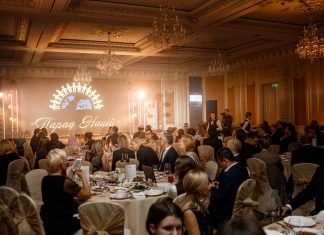Maksym Piatakov, WOG CAFÉ in an exclusive interview for the FD talks about the formation, development and ambitious goals of the WOG CAFE network.
– Today, the WOG CAFE network in Ukraine has 363 facilities; it has the servicing at 16 Intercity trains and 7 cafes outside the filling stations. We have sold 26 million coffee cups. And today we can declare that we are the largest coffee seller in Ukraine.
How did the WOGCAFE network start to function?
– The impetus for the creation of the WOGCAFE network was caused by the active development of public catering at WOG filling stations, and this development has been transformed into an understanding that the food we sell at filling stations (coffee, pastries, hotdogs) should be positioned as part of the food in filling station complexes. Looking at foreign experience, our filling stations developed on the principle of related sales. This is an accompanying sale of those goods that are necessary for the road as well as food. Different networks position themselves in different ways.
Either they have a single brand, or they have separate brands for each of the directions. Our network until 2013–2014 worked in the same way. WOG was branded as a fuel station, and the San Bank brand was an object where you can swaddle where you can buy goods on the road. There were TastyDrive objects – the conventionally zoned café at large filling stations. And there was another brand – Restorio that combines restaurant with service and ceramic dishes. These were different brands in the same network. We did not have a unified assortment, and due to that we made a decision to unify the products that can be taken. For the purpose we took development in to go format. That is, in order to be able to buy everything that is convenient to buy on the road.
We set ourselves the goal of making our filling stations convenient. We wanted to have a stream because sales are made on the stream. The restaurant did not provide such stream. In addition, at the filling station we lacked space to develop catering establishments. It is difficult to create restaurants at the filling stations, because neither the equipment nor the necessary number of personnel will ever be placed. Therefore, we went by outsourcing in this direction. We ordered the main dishes with the food-producers.
We wanted to sell foods in a frozen or chilled state – that is, to serve the stream. Fast, convenient, profitable and safe. Cooking food at the fuel station is both difficult and risky. We are confident in our production. These include new Ukrainian producers, and experienced producers from the European Union.
So, the food in WOGCAFE is ordered?
– So, this food is not prepared by our divisions. We are working on an outsourcing system, as I said. We have fruitful and close relationships with manufacturers. These relationships are built either on joint projects or on our financing of certain industries. We have invested, for example, in pre-installation.
We shared equipment with other manufacturers. We either independently developed products using the site of a particular enterprise, or developed it together with the technologists of this enterprise. Our brand chef and our technology have joined this process.
How many WOGCAFEs are there in Ukraine today?
– 363 objects at the filling stations, 16 trains, there are 7 outside the filling station. This is what we present. These are objects of different sizes, but for us, all of them do constitute WOGCAFE, because they have our products – sandwiches, coffee, mafins and a certain group of other products under the brand WOGCAFE. Further, depending on the stream and depending on the size of the fuel station, we saturate our cafe assortment. In addition, it may be burgers, it may be fresh salads, it may also be meals. That has already been cooked. But this is all under our brand.
We have removed other related brands.
Why did we do that? We did this for a better understanding of what we have: WOG is a filling station, WOG is a market and WOG is cafes. Thus, we created a kind of network brand.
So, having 363 cafes, 16 trains and 7 cafes outside the filling stations, how many manufacturing facilities should be there in this case?
– We have more than 30 partners in the field of production in different directions – from ingredients to coffee. The fresh meal is supplied to us by two permanent producers from Zaporizhzhia. All of this is built on the basis of our logistics project that we are implementing in the direction of cooled and frozen products, together with the Ukrlogistics Company. This is a Ukrainian–Lithuanian joint venture, a division of Vichunai, the supplier of crab sticks to the Ukrainian market.
You have very high coffee sales figures at WOGCAFE. What about the last year?
– We have sold 26 million coffee cups. Today, we are the largest seller of coffee in Ukraine, and that is despite the fact that we are a company that sells fuel either. According to the operational data, according to the results of the 5 months of 2018, sales of branded hot dogs, burgers, sandwiches grew by 15% almost (comparing with 2017), branded coffee and tea – also by 15%, while sales of desserts grew by more than three times. Sales of stores continue to show steady development, for example, car sales increased by 10%, and sales of soft drinks by 20%. We sell so much coffee that we decided to deal with the process of making this wonderful beverage. At least I got a diploma in this area. I have to understand – and I do it – the production, sorting, delivery and storage of coffee, I understand the varieties and methods of processing coffee beans, and I demand such an understanding of the whole team, because we plan to enter the international level. In addition to the many objects I have already mentioned, there is another project that we have been elaborating. This is a cafe in the Lviv airport and it will be already the 8th cafe outside the fuel station.
What exactly has prompted you to go beyond the limits of the fuel stations?
– We did it at the end of 2015, in November.
 We had been carefully prepared for this. From the very beginning of the active development of catering at the fuel stations, we had an idea to work beyond them. That is to say, we wanted to allow our customers to consume our food not only during travelling, but also in the urban environment. Thus, we wanted to increase the range of our customers – so that our products could be consumed, for example, by a student who does not have a car. We wanted to get people accustomed in this way to our assortment so that when this student can buy a car, he will buy food exclusively at our filling stations. He is already a consumer of our products – both of food and of fuel. Also, it should not be forgotten that fuel stations are the infrastructural objects at which food is only one of the concomitant factors. Therefore, the outlet of our cafe beyond the limits of fuel stations had a strategic significance. We wanted to see how people react to us. We wanted to improve our skills and improve our range. After all, going out in the urban environment, we are starting to compete with many fast food restaurants and many networks, and competition is always tightening and making us stronger. Analyzing our activities outside the fuel station, we realized that we could be the network of cafes, making our own brand. We, after all, already have a network, one of the largest in Europe. It was at that time that Ukrzaliznytsia (Ukrainian Rail Road Company) had declared a competition for catering at the high-speed trains. And in February 2016 we won the competition. We only had 10 days before the project had to be started. Thus, we had only 10 days to adapt our range to meet the requirements of Ukrzaliznytsia and to create the necessary infrastructure for the operation of our cafes in the cars. Trains were handed over to us on the night of March 1. Overnight, the company that serves these trains had changed – so, we had just an opportunity to rebuild these trains to our standards.
We had been carefully prepared for this. From the very beginning of the active development of catering at the fuel stations, we had an idea to work beyond them. That is to say, we wanted to allow our customers to consume our food not only during travelling, but also in the urban environment. Thus, we wanted to increase the range of our customers – so that our products could be consumed, for example, by a student who does not have a car. We wanted to get people accustomed in this way to our assortment so that when this student can buy a car, he will buy food exclusively at our filling stations. He is already a consumer of our products – both of food and of fuel. Also, it should not be forgotten that fuel stations are the infrastructural objects at which food is only one of the concomitant factors. Therefore, the outlet of our cafe beyond the limits of fuel stations had a strategic significance. We wanted to see how people react to us. We wanted to improve our skills and improve our range. After all, going out in the urban environment, we are starting to compete with many fast food restaurants and many networks, and competition is always tightening and making us stronger. Analyzing our activities outside the fuel station, we realized that we could be the network of cafes, making our own brand. We, after all, already have a network, one of the largest in Europe. It was at that time that Ukrzaliznytsia (Ukrainian Rail Road Company) had declared a competition for catering at the high-speed trains. And in February 2016 we won the competition. We only had 10 days before the project had to be started. Thus, we had only 10 days to adapt our range to meet the requirements of Ukrzaliznytsia and to create the necessary infrastructure for the operation of our cafes in the cars. Trains were handed over to us on the night of March 1. Overnight, the company that serves these trains had changed – so, we had just an opportunity to rebuild these trains to our standards.
How many people work at cafes located outside the fuel stations?
– More than 250 people work there. This is a separate business project with its own location, its own dispatch service and its own warehouses.
There is also one more internal project – I mean the dining room for staff working at the railway and not only at our cafes.
How did you get into the airports? Or correctly saying, how have you coped with this direction?
– One of the airports declared a tender, the other one did not. After Intercity we worked with the Ashan network, we opened three coffeebags, so people who make purchases could have some coffee and some meals. These were small retail outlets – from 12 to 20 square meters.
Already after that we went to the airport of Kyiv in Zhuliany that now is named in honour of Ihor Sikorsky. It is, in essence, a mix of business and the state ownership; therefore, we entered into a commercial environment after the negotiation process. We negotiated the lease rates, conditions, prospects, etc. We have commercial rates that are tied to the dollar rate and the passenger flow. In fact, the experience of other world airports was used, if to talk about the rental rates. We have possessed an area of up to 45 square meters, a relatively small number of tables and a counter at which people come up to make an order.
Why did not you place this cafe on the ground floor, where the passengers flow should be bigger?
– Places on the ground floor have already been occupied by other companies in the departure zone.
Does the cafe work successfully?
– Yes, quite successfully. We have very democratic prices and therefore the passengers like this facility. The prices, of course, are different from those ones that are at fuel stations, but not radically.
When you left moderate prices at the airport, were not you blamed by your competitors for a kind of dumping?
– No, because such an assortment, as we have the other cafes that work at the airport do not have. Different products cost differently.
And yet, when a powerful company like yours starts to implement actively and successfully its projects, how do the competitors react?
– Sure, the attacks of competitors occur. We work very carefully with the complaints of our clients, and if people are not satisfied with the level of service or quality of food, we conduct official investigations, make compliments in the form of dishes, always thanking for the feedback.
What are your next ambitious goals?
– Among these goals, there is, in particular, the airport “Lviv”. Setting the network up, we have identified priorities for ourselves. It means that we have to be a part of the infrastructure.
We want to get into every airport in Ukraine. The aviation has been developing, new international airlines join our market, and people are flying more after having of the visa-free regime with EU. We are currently launching a pilot project with a Ukrainian air company that is in charge of the charter flights. As for international cooperation, we plan to open stationary cafes at airports abroad, but this is already a challenge for the nearest future.













